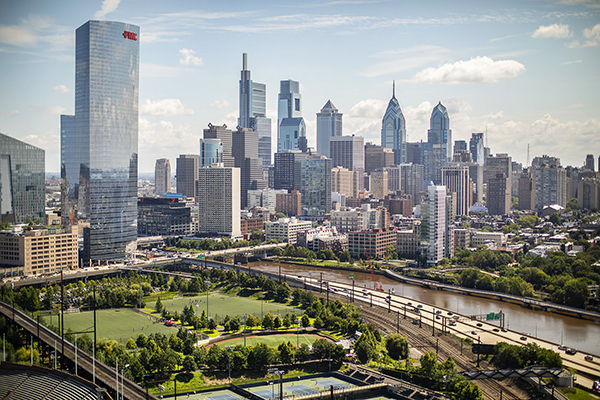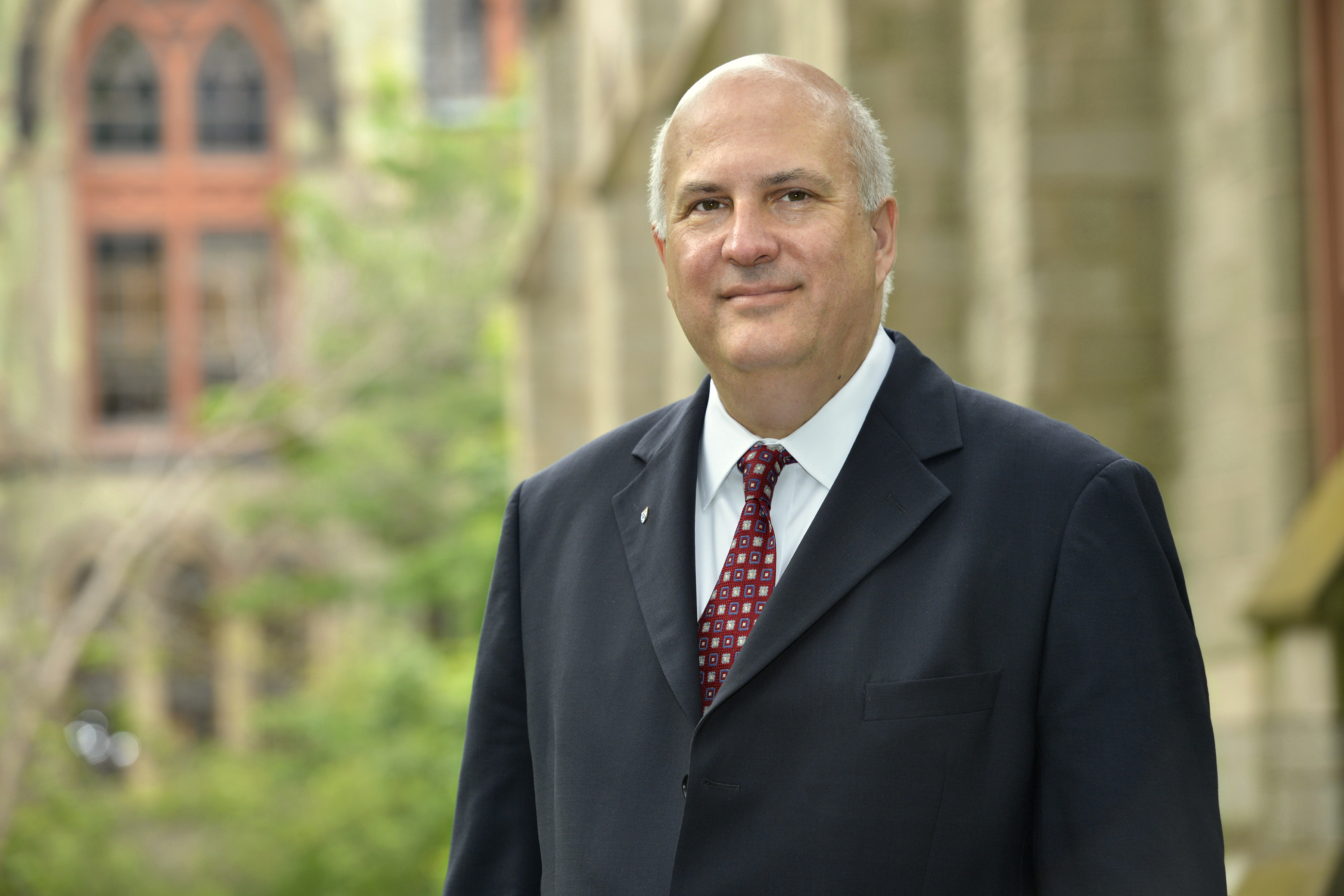
Every five years, the University of Pennsylvania releases an Economic Impact Report, with the goal of analyzing campuswide operations to assess and formally quantify the broad and deep effects that Penn has on the city, state, and regional economies.

Among the significant insights of this year’s report, covering fiscal year 2020, is the profound reach of Penn’s presence, generating $15.5 billion in economic activity in Philadelphia, $20.5 billion within the Commonwealth of Pennsylvania and $21.5 billion in the region.
A new aspect of the latest report is an evaluation of the University’s local civic impact, a key component of President Amy Gutmann’s Penn Compact, with a focus on educating students as global citizens focused on doing good in the world, addressing social needs both near and far.
To dive deeper, Penn Today spoke with Executive Vice President Craig Carnaroli, a longtime leader at Penn with deep roots in the community, about what the report illustrates, the impacts it measured, and his perspective on its findings.
Penn’s economic impact numbers are tremendous. These kinds of huge figures can be hard to fully grasp. How do you think about that impact in terms of what it means for everyday Philadelphians?
Right, these are large numbers and it can be tough for a person to comprehend or visualize what $20 billion looks like. One way is to break it down.
This economic activity touches one in eight Philadelphians. I think that’s something people can think about in their own circles—or now, in our new vernacular, our pods—and say, wow, there’s a connection here, either directly or indirectly, to the economic activity of Penn. I think that gets at the tangible nature of it.
Ultimately, we’re able to use our dollars to multiply economic activity in the city. There are multiple ways that we are bringing dollars in, whether it’s through our research, philanthropy, or events. When we host conferences or Alumni Weekend, there’s a ripple effect through the local company, for example, in restaurants and hotels. That facilitates the caterer over in Powelton Village or a local web designer to grow their business.
You serve as essentially the University’s top economic development official, which also makes you one of the top advisors on economic development in the city. How do you see the Philadelphia economy and how does that influence your work for Penn?
When you look at where the jobs are in the city, there’s a dependence on the ‘eds and meds’ economy. And remember Penn is part of a larger eds and meds ecosystem along with CHOP [Children’s Hospital of Philadelphia], Temple, Jefferson, and Drexel. In this environment, with the pandemic, both of those sectors have been strained—not to the point of large reductions in employment—but enrollment for a lot of the colleges and universities in the region was affected, and the hospitals’ patient activity was severely constrained in responding to the pandemic.
Being an eds and meds economy does characterize Philadelphia, but what’s interesting is how that’s increasingly changing and diversifying. Building on some of the strengths we have in the life sciences, particularly in cell and gene therapy, we’re seeing a number of spinoff companies emerge from that research. We are viewed from the outside as a hub, an epicenter of this activity. In fact, the Chamber of Commerce’s Recharge and Recovery efforts lists growing the cell and gene sector as one of its core pillars.
As I work with external bodies, whether it’s the Chamber or PIDC [Philadelphia’s public-private economic development corporation], I try to help them see the strengths and needs of Penn, so that when we meet with the governor, or prepare for possible stimulus funding, we can try to make a case for investments in infrastructure we need to help these industries be stimulated and grow.
You touched on this a bit, but certainly one compelling aspect of the report is the role of innovation in economic development in Philadelphia. How do you see this playing out?
An analogy I like to use is that of importing and exporting. Historically, if you license your technology to a third party, you basically end up being a net exporter. In other words, you get the benefit of your innovation if it has success, you get cash coming in, but you’ve missed out on the larger economic impact of job creation and all the accompanying benefits emanating from this activity.
Penn’s impact on the city and region at large is on our role as a net importer of dollars. And by that I mean the federal grants that we’re able to garner through our outstanding faculty, that money comes into the city and allows us to employ more people, attracting people who want to be in this area. So there’s a multiplier effect.
It’s the virtuous circle idea. Research leads to disclosures, these disclosures lead to patents, and, ultimately, could lead to license agreements or startups. Then capital comes in to fund that startup. That’s exactly what we're seeing in the cell and gene space.
Penn’s been involved in areas of social and civic engagement, particularly in West Philadelphia, for a long time. What was the impetus to try to quantify that impact for the first time?
The president and provost designated civic engagement as the academic theme year for 2020-21. My colleague, Tony Sorrentino, suggested we apply the theme to the next generaton of Economic Impact Report by incorporating a methodology to measure civic engagement. It’s something we've thought about for a while and it's been a vexing challenge. We get a lot of good feedback on the quality of our Economic Impact Report—we field a lot of calls from people wanting to emulate it—and we want to stay ahead of the game.
At the same time, I would be remiss if I didn’t acknowledge that, increasingly, there are calls for us to do more. I felt that, if we can aggregate this local impact in some way, we can help people build a better understanding about what we are currently doing. And Tony has done a good job at translating the numbers into stories, which help people understand it.
This also comes back to when Amy Gutmann became president, with the original Penn Compact vision that called for engagement, which has now been incorporated into a larger goal around impact. That vision of the Penn Compact resonated with so many of our schools and centers as well as our students, faculty, and staff who study, work, and live in Philadelphia and its neighboring communities. And we want to be able to articulate the ways they contribute to impact. We’ve done this foundational work and hope to refine it as we move forward. But I think this will help people visualize how their work is part of the larger strategic vision for the University.
Beyond your role as Penn’s executive vice president, you have a lot of connections to West Philadelphia, serving as board chair of the University City District board for years, among many other volunteer positions. What does seeing this level of impact mean to you personally?
I feel a personal commitment to Philadelphia and University City, I live and work here too. There’s nothing like being out, experiencing the authenticity of the community, whether it’s West Philadelphia, or greater Philadelphia, and building this network of relationships. That’s what these board roles have allowed me to do.
Like at University City District [UCD], one of the nice things is that the community associations—there are five local ones, Spruce Hill, Garden Court, Walnut Hill, Powelton Village, Cedar Park—they actually have seats on the board. So it isn’t just the institutions like us thinking about what’s good for them; they’re actually there giving us feedback. It's allowed me to gain a better appreciation for how diverse and how committed the neighborhood residents are.
One story I love to tell is when Ira Harkavy and Cory Bowman of the Netter Center for Community Partnerships came to see me and said, there's this money in workforce development and we really need UCD to take this on. Here I am, 13 years later, and we’re celebrating it. Just this past weekend there was a story in The Philadelphia Inquirer, about 50 new medical technicians hired at Penn Medicine, coming through the UCD West Philadelphia Skills Initiatives. It just really warms my heart.
There is this one man that I’m so fond of. He was formerly incarcerated, and grew up in the neighborhood. He had different troubles in life, but is now the manager of the landscaping crew, called GreenCity Works, a social enterprise of UCD. And he’ll tell me how this program put his life on a completely different trajectory. He has demonstrated to me firsthand that these efforts can positively impact lives and that's some of the joy of being engaged beyond the ‘regular work job,’ if you will.
A copy of the report may be found on the website of the Office of the Executive Vice President.
- $21.5 billion
The annual economic activity Penn generated around the region in fiscal year 2020
- 114,350
The number of jobs the University inspired
- $590 million
Amount of venture capital raised
- $42 million
Daily economic activity Penn generated in the city of Philadelphia
- 10
Number of cell and gene therapy startup companies headquartered in Philadelphia
- 1 in 8
The number of employed Philadelphians impacted by Penn’s presence and economic activity
- $27 million
Amount of Penn Medicine funds to support West Philadelphia communities in unreimbursed health care, women’s health clinics and community health programs
- 344,000
Number of hours spent on civic engagement by Penn faculty, staff, and students, touching roughly 718,000 Philadelphians







